|
|
EDITORIAL:Rejuvenation and Rapid Growth on Electrochromism Researches
DIAO Xungang
2021 Vol. 36 (2): 113–114
 Abstract
Abstract(
58 )
 HTML
HTML(
0)
 PDF
PDF(237KB)(
841
)
Electrochromism is a typical multidisciplinary crossing research field, involving organic and inorganic materials, physics and chemistry, electronics and optics, testing and controlling and packaging technologies, solar energy and radiation spectral modulation and energy conservation, color and thermal controlling, and many other basic and applied researches. In recent years, electrochromism researches exhibits a colorful and exciting revival trend, especially after many Chinese scientists and companies came into this field. It brings vitality into the international electrochromism research community, which has been a little tranquil for many years. This conclusion can be detected from comparison of the participants number in international and domestic professional academic electrochromic conferences. The bi-annually International Meeting on Electrochomism-IME has been held the 13th session until now, with the number of participants remaining around 150 in recent several times. But for the two-yearly Chinese Meeting on Electrochromism-CME, the number of participants has been quickly increasing from 26 at the 1st, 150 at the 2nd, 178 at the 3rd, to 352 at the 4th CME held in August 2019. Both Chinese academics and industries are very interested in electrochromism. Each CME participants are composed of a third from academic researchers, a third from graduate students, and a third from industries. In March 2020, commissioned by editorial board of Journal of Inorganic Materials, Prof. WANG Jinmin and I organized the special issue (Electrochromic Materials and Devices) for the Journal. It was the exact and tough period when COVID-19 epidemic ravaged in Wuhan, the whole China and then in Europe. Our scientists and graduate students were working even harder in order to fight against the epidemic with great solidarity and simultaneously to contribute and devote to our beloved motherland. Our electrochromism colleagues strongly support and cooperate, actively contributing manuscripts. As a result, series of the work such as manuscripts invitation and submission and reviews etc., had been progressing very smoothly. We had early planned to publish just one issue, but received much more manuscripts with quite high quality, and finally decided to publish two special issues with permission of the journal’s editorial. We have invited the most prestigious research groups in China to contribute to our special issue, and they are all leaders in the field of inorganic electrochromism researches. It is expected that these professional academic works can further promote the vigorous development of electrochromic research and industrialization technologies in China. On behalf of my colleagues in the field of electrochromism, I would like to express my sincere thanks and respect to the authors and editors who have made outstanding contributions to the special issue’s publication.
|
|
|
Multi-functional Electrochromic Devices: Integration Strategies Based on Multiple and Single Devices
FAN Hongwei, LI Kerui, HOU Chengyi, ZHANG Qinghong, LI Yaogang, WANG Hongzhi
2021 Vol. 36 (2): 115–127
 Abstract
Abstract(
190 )
 HTML
HTML(
6)
 PDF
PDF(5038KB)(
1779
)
Electrochromism is the phenomenon of reversible color/optical change of materials induced by redox reactions under an applied electric field. Since electrochromism was first introduced by Platt in 1961, electrochromic (EC) technology continues to develope due to its advantages of multiple colors energy saving and controllability, and was applied in many fields, for example, smart windows, displays, anti-dazzling rear view mirrors, etc. Recently, with the rapid development of optoelectronic and photoelectric technologies, highly integrated electronic devices attracted extensive interests, and the EC technology is developed towards functionalization and intellectualization. For example, self-powered EC devices (ECDs) were fabricated through integrating with the green energy technology, which further reduced the building energy consumption. Because of the visualization of the EC phenomena by naked eyes, the signal reading became more convenient for the sensors integrated with ECDs. In addition, because of similar device structure, electrochemical principles, active components with other functional devices, a lot of multifunctional EC technologies were explored based on single device, facilitating applications of ECDs in EC infrared control, EC energy storage, and EC actuation. In light of the recent emerging progress of EC technology, we reviewed multi-functional EC systems based on the integration of multiple devices and single device, respectively, including self-powered ECDs, EC sensors, infrared ECDs, and EC energy storage devices, etc. The integration modes, structure design and performance optimization were also summarized for different types of the multi-functional ECDs. At last, we introduced the challenges and potential pathway of multi-functional EC integration in the future.
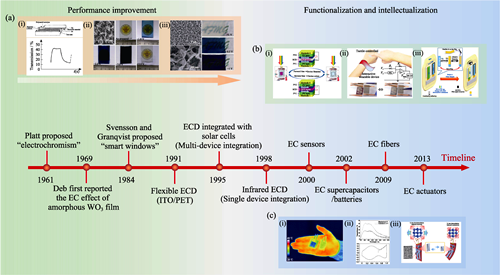
|
|
|
Electrochromic Devices Based on Tungsten Oxide and Nickel Oxide: a Review
ZHONG Xiaolan, LIU Xueqing, DIAO Xungang
2021 Vol. 36 (2): 128–139
 Abstract
Abstract(
240 )
 HTML
HTML(
7)
 PDF
PDF(10145KB)(
2463
)
Electrochromic devices (ECDs) are the intelligent devices change color by applying electric potential, with the advantages of wide working temperature, high optical contrast, good reversible bistability, low driving voltage, and low energy consumption, which show great application potential in the field of dynamic smart windows, full-color electronic screens, anti-glare goggles, adaptive dual-stealth camouflage, and energy storage status visualization. Cathodically coloring material tungsten oxide and anodically coloring material nickel oxide are two widely studied inorganic electrochromic materials, and complementary electrochromic devices based on WO3 and NiO films have high commercial values in the application of large scale smart windows. Improving the performance of the complementary ECDs such as optical modulation range, response rate, cycle life and weather fastness has attracted much attention. This review focuses on the structural composition of complementary electrochromic devices and summarizes the recent research progress of the electrochromic full devices based on WO3 and NiO. Firstly, the electrochromic mechanism and decay mechanism of WO3 and NiO films are clarified, the effects and latest research progress of four strategies for film performance optimization that include optimizing preparation conditions, element doping modification, designing nanostructure, and introducing composite materials are discussed in detail. Secondly, according to the composition and structure design of the device, the classification system of the complementary electrochromic full device is introduced, and the influence of selection for each component material and the device structure on device overall performance are summarized. Finally, the application of the electrochromic device prospects and development trends are forecasted.
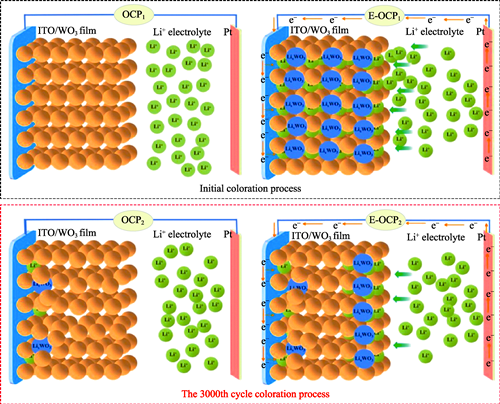
|
|
|
Progress in Flexible Electrochromic Devices
FANG Huajing, ZHAO Zetian, WU Wenting, WANG Hong
2021 Vol. 36 (2): 140–151
 Abstract
Abstract(
361 )
 HTML
HTML(
9)
 PDF
PDF(3361KB)(
2256
)
Electrochromic materials with ability of changing color in response to periodically adjusted bias are an important class of optoelectric functional materials. The controllable modulation of light absorption and transmission can make a great contribution in applications such as smart windows, electrochromic displays and antiglare rear-view mirrors. In recent years, electrochromic technology has developed rapidly. However, the research so far mainly focuses on the traditional rigid electrochromic devices (ECD), mostly based on transparent conductive glass such as indium tin oxide (ITO) glass. The rigid electrochromic devices have some noticeable problems such as large thickness, poor conformability, low mechanical strength, high cost, etc., which hinder their further development of electrochromic technology and their forward commercialization. With the upsurge of developing flexible devices that can be used in wearable devices and e-skin, flexible electrochromic devices (FECD) have attracted extensive attention due to their possibility of foldability, wearability and even embeddability, and have become a research hotspot in the electrochromic field. Starting from the materials for preparing FECD, this review systematically summarizes the recent progress and trend of flexible electrochromic devices based on inorganic, organic, inorganic/organic composite and other new materials. The review also focuses on the research progress of up to date stretchable electrochromic devices. At the same time, challenges in performance improvement and practical application of flexible electrochromic devices at the present stage as well as the corresponding measures taken in the literatures are discussed. Finally, the key to the preparation and performance improvement of flexible electrochromic devices is defined, and the future development trend is prospected.
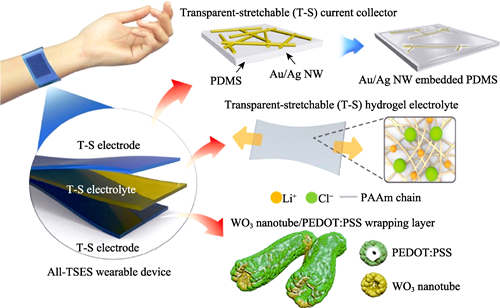
|
|
|
Dynamic Process of Ions Transport and Cyclic Stability of WO3 Electrochromic Film
ZHOU Kailing, WANG Hao, ZHANG Qianqian, LIU Jingbing, YAN Hui
2021 Vol. 36 (2): 152–160
 Abstract
Abstract(
278 )
 HTML
HTML(
3)
 PDF
PDF(1354KB)(
1289
)
The dynamic process of ions transport in electrochromic WO3 film is usually studied by electrochemical impedance spectroscopy. However, the detailed features are hidden since the ions insertion into WO3 is a very complex process including structural deformation and phase transformations. Chronopotentiometry is an electrochemical characterization method that measures the response potential of a system under an imposed current. Compared to other dynamic characterization methods (impedance spectroscopy and CV), it allows direct access to the voltage contributions in different states of the solution-electrode system and has frequently been used to investigate kinetic effects such as adsorption and transport phenomena near electrode surface. In this study, chronopotentiometry is creatively applied to study ion transport kinetics and control ions insertion behavior in electrochromic WO3 film. The results suggest that a large ions insertion flux at the interface of WO3/electrolyte could broaden ions transport channels due to the fierce lattice expansion during Li+ions insertion process, which further improves the ions transportation kinetics and gifts a fast switching speed of optical performance. However, the repeating ions insertion/extraction behaviors at the interface of WO3/electrolyte for the long-term cycle process can reduce the size of WO3 grains as a “ball mill effect”. Especially, a large ions transport flux can aggravate the “ball mill effect”. Consequently, the structure of the WO3 film becomes very dense, which is unfavorable for ions transport and electrolyte permeation. This dense structure also leads to an irreversible accumulation of Li+ ions and LixWO3 in the WO3 host structure, resulting in a decay of optical modulation ability and electrochromic activity. This work offers an efficient method to analyze ion transport kinetics in intercalation materials and a new understanding of the relationship between ion transport behavior and cyclic stability of electrochromic materials.
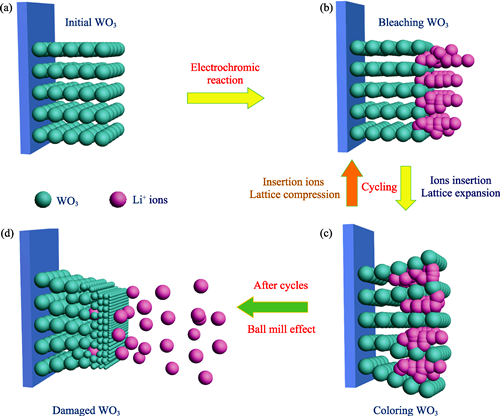
|
|
|
High-conductivity Hydrophobic Fumed-SiO2 Composite Gel Electrolyte for High Performance Electrochromic Devices
ZHAO Qi, QIAO Ke, YAO Yongji, CHEN Zhang, CHEN Dongchu, GAO Yanfeng
2021 Vol. 36 (2): 161–167
 Abstract
Abstract(
214 )
 HTML
HTML(
0)
 PDF
PDF(9643KB)(
1220
)
Gel electrolytes are chemically stable, nonflammable and easy to encapsulate, however, their moderate ionic conductivity (10-4-10-5S?cm-1) hinders their further development for the usage in electrochromic devices (ECDs). Here, we developed a highly conductive hydrophobic SiO2/PMMA/PC/LiClO4 gel polymer electrolyte (H-SiO2 GPE). Electrochemical behaviors of ECDs were characterized by electrochemical impedance spectroscope (EIS), cyclic voltammetry (CV) and chronoamperometry (CA). Systematic analyses show that the ionic conductivity of the H-SiO2 GPE can reach 5.14 mS?cm-1 (at 25 ℃) by introducing only 0.5wt% hydrophobic fumed SiO2. This increase is due to the good compatibility and hydrophobic-hydrophobic attractions between SiO2 additive and organic electrolyte, which promotes the dissociation of lithium perchlorate. Additionally, the viscosity as a function of shear rate for GPE with various fumed silica contents shows the behavior of shear thinning, which indicates the formation of a three-dimensional network structure. This structure provides ion transport channels, leading to a clearly improved switching speed for ECDs assembled with hydrophobic SiO2 GPEs (tbleaching=4 vs 8 s and tcoloring=14 vs 16 s). Similarly, the investigation of hydrophobic fumed SiO2 in liquid electrolyte is demonstrated that the ionic conductivity of LiClO4/PC liquid electrolyte without and with hydrophobic fumed SiO2 increases from 6.94 to 7.58 mS?cm-1, respectively. Therefore, hydrophobic fumed SiO2 as a filler has a positive effect on electrolytes, and the proposal of the H-SiO2 GPE provides a new idea for offsetting the trade-off between a high ionic conductivity and easy leakage when applied in ECDs.
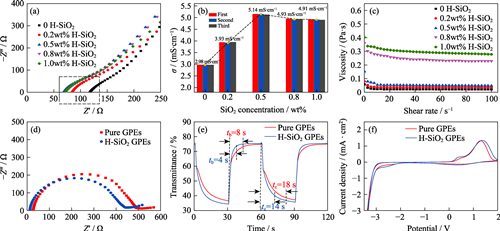
|
|
|
Effect of SnO2 Annealing Temperature on the Performance of Perovskite Solar Cells
WANG Yanxiang, GAO Peiyang, FAN Xueyun, LI Jiake, GUO Pingchun, HUANG Liqun, SUN Jian
2021 Vol. 36 (2): 168–174
 Abstract
Abstract(
1186 )
 HTML
HTML(
72)
 PDF
PDF(6629KB)(
1513
)
Electron transport layer is a key part for perovskite solar cell (PSC), which can block holes and transmit electrons to reduce recombination. In this study, SnO2 was synthesized with low-temperature solution-processed method and used as electronic transport layer for perovskite solar cells. The influence of annealing temperature on the properties of SnO2 films and PSCs were systematically studied. The results showed that with the annealing temperatures at 60, 90, 120, 240 ℃, the surfaces of SnO2 films own more pores; while annealed at 150, 180, 210 ℃, the corresponding surfaces show fewer pores. It was found that the transmittance of FTO glass covered with SnO2 films is better than that of the bare FTO glass. With SnO2 annealed at 180 ℃, the electron mobility of the thin film is the highest. The corresponding PSC possesses the best transmission resistance, composite resistance, and superior photovoltaic performance. The photoelectric conversion efficiency, the open-circuit voltage, the short-circuit current and the filling factor were 17.28%, 1.09 V, 20.91 mA/cm2 and 75.91%, respectively.
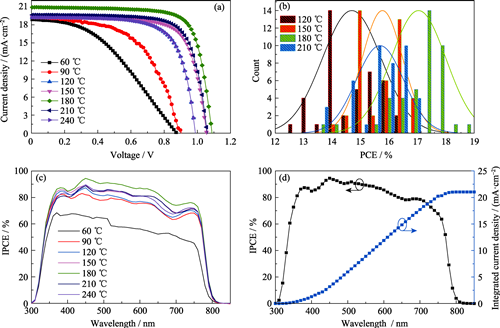
|
|
|
Storage Aging Mechanism of LiNi0.8Co0.15Al0.05O2/Graphite Li-ion Batteries at High State of Charge
LIU Yong, BAI Haijun, ZHAO Qizhi, YANG Jinge, LI Yujie, ZHENG Chunman, XIE Kai
2021 Vol. 36 (2): 175–180
 Abstract
Abstract(
574 )
 HTML
HTML(
20)
 PDF
PDF(3763KB)(
1117
)
Storage life at high state of charge is a key factor affecting the application of Li ion battery, but the related mechanism research is insufficient. In this study, the storage life of LiNi0.8Co0.15Al0.05O2 (NCA)/graphite battery was evaluated via accelerating experiment at elevated temperature, and the electrochemistry performances and interface properties of fresh and aged active materials were analyzed. Storage experiment shows that the storage life of NCA/graphite battery at high state of charge under 55 ℃ is about 90 d. Electrochemical test shows that the capacities of NCA and graphite decrease when the batteries reach the end of life, but that is not the main cause inducing capacity degradation. Interface analysis illustrates that the solid electrolyte interface (SEI) film on graphite anode significantly grows when batteries reach the end of life, while the positive solid electrolyte interface (PEI) film on NCA cathode keeps basically unchanged. The growth of SEI film on graphite owing to the decomposition of carbonates in electrolyte results in Li loss in anode, which contributes to the capacity loss of NCA/graphite battery during the storage aging at high state of charge.
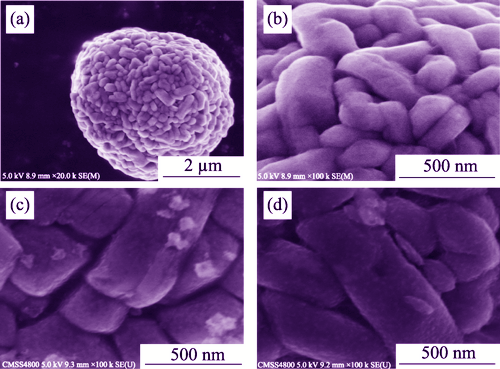
|
|
|
Construction of Sustainable Release Antimicrobial Microspheres Loaded with Potassium Diformate
GUO Xiaowei, LI Yuyan, CHEN Nanchun, WANG Xiuli, XIE Qinglin
2021 Vol. 36 (2): 181–187
 Abstract
Abstract(
423 )
 HTML
HTML(
10)
 PDF
PDF(2598KB)(
683
)
To prevent potassium diformate (KDF) from decomposing too quickly in an acidic environment, adjust the acidity and alkalinity of the gastrointestinal tract of the piglets and the colony balance, and realize the targeted release of KDF antibacterial, in this study, a kind of hydrogel microspheres were prepared by biodegradable chitosan (CS), carboxymethyl cellulose (CMC), and inorganic rigid material P-type molecular sieve (Zeolite P). Then the antibacterial drug potassium diformate was loaded so as to be controlled to release from this hydrogel microsphere. The results show that -NH2 in CS and -COOH in CMC form a stable polyelectrolyte complex through ion interaction. Swelling rate test indicates that the CS/CMC/Zeolite P hydrogel microspheres display high pH-sensitivity. The addition of Zeolite P allows the hydrogel microspheres to maintain their original morphology at pH1.2 without being degraded or broken. The effective sustained-release KDF in pH7.4 phosphate buffer solution exhibits better sustained-release performance than that in pH1.2. When the concentration of CS/CMC/Zeolite P/KDF antimicrobial microspheres is 96 mg/mL, the maximum bacteriostatic rate of Escherichia coli is 83%, which effectively improves the utilization rate of KDF.
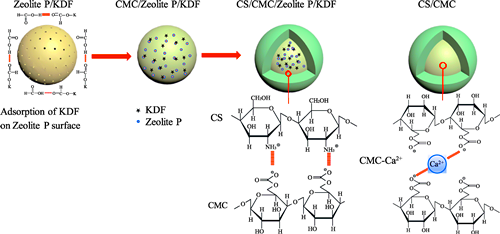
|
|
|
Twisted Growth, Component Segregation and Characteristics of Gd3(Al,Ga)5O12:Ce Scintillation Crystal
MENG Meng, QI Qiang, DING Dongzhou, HE Chongjun, ZHAO Shuwen, WAN Bo, CHEN Lu, SHI Junjie, REN Guohao
2021 Vol. 36 (2): 188–196
 Abstract
Abstract(
585 )
 HTML
HTML(
13)
 PDF
PDF(1228KB)(
914
)
There are many problems such as polycrystal twisted growth and component segregation during the preparation of the new scintillation crystal Gd3(Al,Ga)5O12:Ce (abbreviated as GAGG:Ce) by the Czochralski method. In order to solve these problems to obtain large-size and high-quality GAGG:Ce crystals, with a combination of melt characteristics, formation mechanism of twisted growth, component segregation, spectral characteristics and scintillation performance of GAGG:Ce crystals were studied. A complete GAGG:Ce crystal with size of ?50 mm× 120 mm was successfully grown by adjusting the temperature field and inhibiting the volatilization of the components. The results show that light output of the GAGG:Ce crystal sample (10 mm×10 mm×2 mm) is 58000 ph./MeV, while energy resolution is 6.4%@662 keV with transmittance at 550 nm of 82%, decay time of 126 ns (83%), and the slow component is 469 ns (17%). The peak position of emission wavelength of the crystal is about 550 nm, which matches well with the silicon photomultiplier. Meanwhile, the emission weighted longitudinal transmittance is as high as 79.8%. GAGG:Ce crystal has an excellent combination of high light output and energy resolution, and all of these properties show that GAGG:Ce crystal is a promising scintillator for neutron and gamma detection applications.
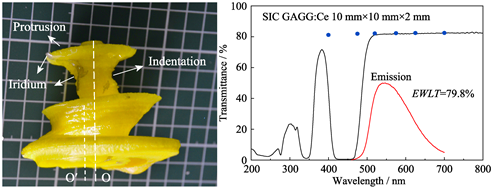
|
|
|
High Temperature Interfacial Stability of Fe/Bi0.5Sb1.5Te3 Thermoelectric Elements
WANG Xu, GU Ming, LIAO Jincheng, SONG Qingfeng, SHI Xun, BAI Shengqiang, CHEN Lidong
2021 Vol. 36 (2): 197–202
 Abstract
Abstract(
560 )
 HTML
HTML(
17)
 PDF
PDF(2568KB)(
1028
)
The high temperature interfacial stability of thermoelectric (TE) elements, which is mainly evaluated by the inter-diffusion and interfacial resistivity at the interface between the barrier layer and the TE material, is one of the key factors determining the service performance and application prospects of TE devices. In this study, a screening method based on high-throughput strategy was employed to further improve the interfacial stability of P-type bismuth telluride TE devices, and Fe was proved the preferred barrier layer material for P-type Bi0.5Sb1.5Te3 (P-BT). Then Fe/P-BT TE elements were prepared by one-step sintering. Evolution of the Fe/P-BT interfacial microstructure during high temperature accelerated aging was systematically studied, and stability of the interfacial resistivity was explored. It is found that during aging, the Fe/P-BT interface is well bonded and the composition of the ternary Fe-Sb-Te diffusion layer remains basically unchanged. The diffusion layer thickness increases linearly with the square root of the aging time and the growth activation energy is 199.6 kJ/mol. The initially low interfacial resistivity of the Fe/P-BT interface increases slowly with the prolonged aging time but remains below 10 μΩ·cm2 even after 16 d at 350 ℃. The life prediction based on the interfacial diffusion kinetics indicates that Fe is a suitable barrier layer material for Bi0.5Sb1.5Te3 TE elements.
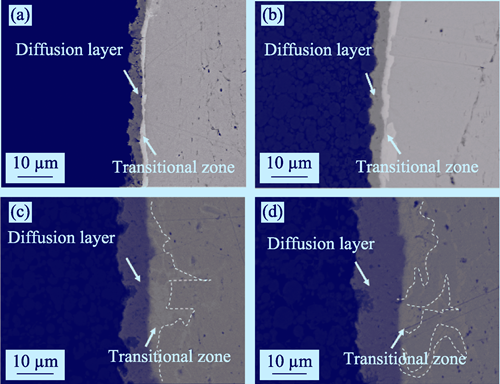
|
|
|
Cobalt-doped Hollow Carbon Framework as Sulfur Host for the Cathode of Lithium Sulfur Battery
JIN Gaoyao, HE Haichuan, WU Jie, ZHANG Mengyuan, LI Yajuan, LIU Younian
2021 Vol. 36 (2): 203–209
 Abstract
Abstract(
847 )
 HTML
HTML(
32)
 PDF
PDF(3322KB)(
1144
)
Lithium-sulfur batteries are deemed to be the next generation of cost-effective and high energy density systems for energy storage. However, low conductivity of active materials, shuttle effect and sluggish kinetics of redox reaction lead to serious capacity fading and poor rate performance. Herein, a sodium citrate derived three-dimensional hollow carbon framework embedded with cobalt nanoparticles is designed as the host for sulfur cathode. The introduced cobalt nanoparticles can effectively adsorb the polysulfides, enhance the kinetics of conversion reaction and further improve the cyclic and rate performance. The obtained cathode delivered a high initial discharge capacity of 1280 mAh·g-1 at 0.5C, excellent high-rate performance up to 10C and stable cyclic capacity of 770 mAh·g-1 at 1C for 200 cycles with high Columbic efficiency.
|
|
|
Fabrication and Optical Property of Nd:Lu2O3 Transparent Ceramics for Solid-state Laser Applications
LIU Ziyu, TOCI Guido, PIRRI Angela, PATRIZI Barbara, FENG Yagang, CHEN Xiaopu, HU Dianjun, TIAN Feng, WU Lexiang, VANNINI Matteo, LI Jiang
2021 Vol. 36 (2): 210–216
 Abstract
Abstract(
706 )
 HTML
HTML(
14)
 PDF
PDF(2170KB)(
985
)
Nd 3+ doped Lu2O3 crystal has been suggested to be potential gain medium for high-power solid-state lasers due to the high thermal conductivity, low phonon energy and excellent optical properties. Because of the extremely high melting point of above 2400 ℃, great attention has been paid to the Lu2O3-based transparent ceramics considering the comparable optical properties and laser performance with single crystal. In this work, we aimed at fabricating highly transparent Nd:Lu2O3 ceramics and investigating the optical properties and laser performance. 1.0at%Nd:Lu2O3 ceramics were fabricated by two-step sintering, namely vacuum sintering along with hot isostatic pressing (HIP) method, from coprecipitated nano-powders. The microstructures of the as-prepared powder, green body and ceramics were studied. The average grain size of the HIPed ceramics is 724.2 nm. The final ceramic sample has the in-line transmittance of 82.4% at 1100 nm (1.0 mm thickness). The absorption cross-section of 1.0at%Nd:Lu2O3 ceramics at 806 nm is 1.50′10-20 cm2 and the calculated emission cross-section from fluorescence spectrum at 1080 nm is about 6.5′10-20 cm2. The mean fluorescence lifetime, 169 ms, of the4F3/2·4I11/2 was measured at the two excitation wavelengths of 878.8 and 895.6 nm, respectively. Laser performance of the annealed ceramic sample was investigated in quasi-continuous wave (QCW) condition. A maximum laser output power of 0.47 W with a slope efficiency of 8.7% is obtained by using an output coupler with a transmission of TOC=2.0%. Briefly, laser level Nd:Lu2O3 transparent ceramics with high optical transparency and uniform microstructure have been fabricated, which are promising gain media for solid-state lasers.
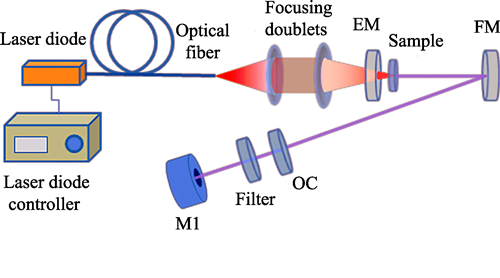
|
|
|
Fabrication and Characterizations of Yb:YAG Transparent Ceramics Using Alcohol-water Co-precipitation Method
HUANG Xinyou, LIU Yumin, LIU Yang, LI Xiaoying, FENG Yagang, CHEN Xiaopu, CHEN Penghui, LIU Xin, XIE Tengfei, LI Jiang
2021 Vol. 36 (2): 217–224
 Abstract
Abstract(
683 )
 HTML
HTML(
18)
 PDF
PDF(6480KB)(
898
)
Yb 3+ doped YAG transparent ceramics have great potential as gain medium for high-power solid-state lasers due to many advantages, such as broad absorption and emission bands, high gain, low thermal loading, long fluorescence lifetime and high quantum efficiency. So Yb:YAG transparent ceramics have gradually been paid more attention. In this work, we aimed at optimizing the properties of powders to fabricate highly transparent Yb:YAG ceramics. 5at%Yb:YAG nano-powders were synthesized via the co-precipitation method by using ammonium hydrogen carbonate as the precipitant, and pure water or alcohol-water mixture as the solvent. All powders calcined at 1250 ℃ for 4 h exhibit a pure YAG phase. Compared to the one with pure water solvent, the 5at%Yb:YAG powder synthesized with alcohol-water solvent exhibits smaller average crystallite size and lower agglomeration degree. 5at%Yb:YAG transparent ceramics were successfully fabricated by vacuum sintering without sintering additives from the obtained powder with alcohol-water solvent. The microstructure and in-line transmittance of the ceramics sintered at 1500-1825 ℃ for 20 h and 1800 ℃ for 10-50 h were investigated. All ceramic samples show a homogeneous microstructure except for that sintered at 1825 ℃ for 20 h. The sample sintered at 1800 ℃ for 50 h shows the highest in-line transmittance of 78.6% at 1100 nm and 76.7% at 400 nm (2.2 mm thickness). The calculated absorption and emission cross sections are 5.03×10-21 cm2 at 937 nm and 13.48×10-21 cm2 at 1031 nm, respectively. Therefore, Yb:YAG ceramics with high optical transparency and uniform microstructure have been fabricated from powder with alcohol-water solvent.
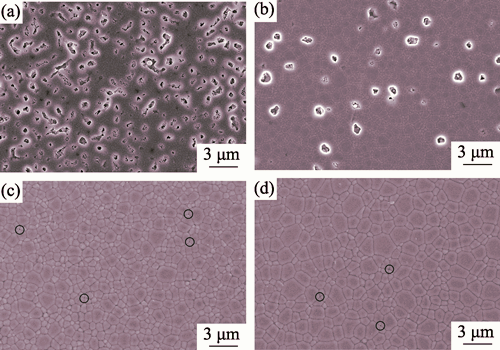
|
|